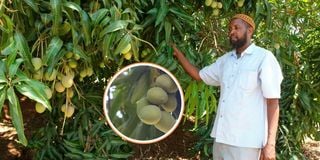Premium
Garissa farmer makes a fortune from mixed cropping

Hassan Ibrahim displays fruits on one of his many mango trees at his farm on October 8, 2024.
What you need to know:
- Ibrahim's farm has several varieties of mangoes, orange, banana guava and pawpaw.
- Social media has helped Ibrahim market his yields and improve farming practices.
Hassan Yussuf Ibrahim, who trained as an automotive technician, has found a fortune in mixed cropping in a region classified as arid.
After graduating from the National Youth Service (NYS) in 1997, Ibrahim made the decision to try a hand in farming. He acquired a four and a half-acre piece near River Tana on the outskirts of Garissa town.
After visiting several farms outside Garissa County and applying the skills he acquired at the NYS, Ibrahim introduced several crops on his land.
He went for mixed cropping – growing different crops on the same piece of land but in a particular pattern.
“I chose mixed cropping to maximise profits. I never wanted my land to be idle at any one time. I am continuously harvesting because these crops mature at different times,” Ibrahim says.
The farm has several varieties of mangoes, lemon, orange, banana, vegetables, pomegranate, guava, pawpaw and water melon.
“The mango varieties on my farm include apple, ngowe, batawi, perch and pawin. I sourced them from Mombasa, Nakuru and other parts of Kenya,” he says.
Ibrahim chose to grow mangoes because of a ready market. Mango plants are also drought-resistant and can withstand floods, common in the region.
“The recent flooding destroyed all the pawpaw trees but mangoes survived,” he adds.
The ripening banana types on Ibrahim’s farm include grand naine, vallery and giant Cavendish. They are planted in rows with kisii, Ugandan matoke, solio, ng’ombe and other cooking varieties.
“Lime plants on my farm include Persian, makrut and desert,” he says.
Lime is a rich source of vitamin C and mostly is sour. It is used to add flavour to food and drinks.
“Returns from mixed crop farming are good because harvests are continuous. When mangoes are out of season, I harvest lime, bananas or other crops that would have matured,” he says.
His goal is to turn the farm into a learning and plant propagation centre.
“Farmers need to get knowledge locally instead of travelling far. This place will soon become a centre of excellence in crop and seed production,” he says.
Social media has helped Ibrahim market his yields and improve farming practices.
“I also attend workshops and other training to improve farming techniques,” he says, adding that he too learns from peers in other counties.
Ibrahim’s profits are marginal as his market is mainly local.
“In times of glut, many fruits go to waste as there is no demand,” he says, adding that he harvests up to three tonnes of mangoes ever year, with a kilo going for Sh60.
“What farmers in Garissa need is value addition for their produce. The devolved government should set up food processors,” Ibrahim says.
Garissa County Agriculture Services Director, Musymi Kyalo , says harvests are still too low to warrant the establishment of a fruit processor in the region.
“We are exploiting other ways that will benefit our farmers,” Kyalo says.
He adds that the county government is in the process of establishing farmers’ cooperatives.
“Co-ops will benefit many. We are helping establish common interest groups too,” he says.
Kyalo says mixed cropping is encouraged in Garissa because it conserves soil.
“We also encourage integrated farming. We are losing grazing fields to global warming but pastoralists are being trained on irrigated farming,” he says.
Kyalo adds that mixed cropping minimises the spread of pests and diseases and improves food security.
“Legumes add nitrogen to the soil. Spacing different crops closely suppresses weeds and less labour is needed for farm operations.
Juma Charo, an agricultural officer, says those practising mixed cropping should be wary of competition between the crops.
Mechanisation is also challenging due to differences in crop morphology.
“Applying fertiliser and pesticides can be problematic,” Charo says.





